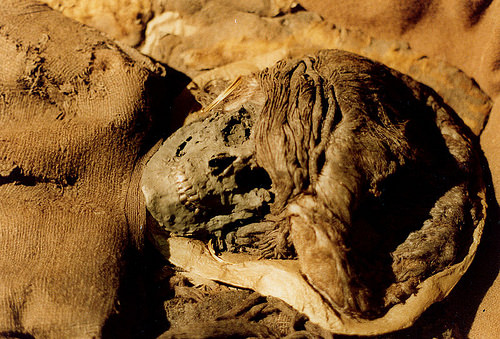
UNIVERSITY OF SHEFFIELD—Ancient Britons may have intentionally mummified some of their dead during the Bronze Age (c. 2500 – 800 BC), according to archaeologists at the University of Sheffield.
The study is the first to provide indications that mummification may have been a widespread funerary practice in Britain.
Working with colleagues from the University of Manchester and University College London, Dr Tom Booth analyzed skeletons at several Bronze Age burial sites across the UK. The team from the University of Sheffield’s Department of Archaeology found that the remains of some ancient Britons are consistent with a prehistoric mummy from northern Yemen and a partially mummified body recovered from a sphagnum peat bog in County Roscommon, Ireland.
Building on a previous study conducted at a single Bronze Age burial site in the Outer Hebrides, Dr Booth used microscopic analysis to compare the bacterial bio-erosion of skeletons from various sites across the UK with the bones of the mummified bodies from Yemen and Ireland.
Archaeologists widely agree that the damp British climate is not favorable to organic materials and all prehistoric mummified bodies that may be located in the UK will have lost their preserved tissue if buried outside of a preservative environment such as a bog.
Dr Booth, who is now based at the Department of Earth Sciences at London’s Natural History Museum, said: “The problem archaeologists face is finding a consistent method of identifying skeletons that were mummified in the past – especially when they discover a skeleton that is buried outside of a protective environment.
“To help address this, our team has found that by using microscopic bone analysis archaeologists can determine whether a skeleton has been previously mummified even when it is buried in an environment that isn’t favorable to mummified remains.
“We know from previous research that bones from bodies that have decomposed naturally are usually severely degraded by putrefactive bacteria, whereas mummified bones demonstrate immaculate levels of histological preservation and are not affected by putrefactive bio-erosion.”
Earlier investigations have shown that mummified bones found in the Outer Hebrides were not entirely consistent with mummified remains found elsewhere because there wasn’t a complete absence of bacterial bio-erosion.
However, armed with a new technique, the team were able to re-visit the remains from the Outer Hebrides and use microscopic analysis to test the relationship between bone bio-erosion and the extent of soft tissue preservation in bone samples from the Yemeni and Irish mummies.
Their examinations revealed that both the Yemeni and Irish mummies showed limited levels of bacterial bio-erosion within the bone and therefore established that the skeletons found in the Outer Hebrides as well as other sites across Britain display levels of preservation that are consistent with mummification.
The research team also found that the preservation of Bronze Age skeletons at various sites throughout the UK is different to the preservation of bones dating to all other prehistoric and historic periods, which are generally consistent with natural decomposition. Furthermore, the Sheffield-led researchers also found that Bronze Age Britons may have used a variety of techniques to mummify their dead.
Dr Booth added, “Our research shows that smoking over a fire and purposeful burial within a peat bog are among some of the techniques ancient Britons may have used to mummify their dead. Other techniques could have included evisceration, in which organs were removed shortly after death.
“The idea that British and potentially European Bronze Age communities invested resources in mummifying and curating a proportion of their dead fundamentally alters our perceptions of funerary ritual and belief in this period.”
________________________________________
The Skrydstrup Woman, example of a European mummy found in a tumulus in Denmark. She was discovered in 1935 and dated to 1300 BCE. Wikimedia Commons
_________________________________________
The research also demonstrates that funerary rituals that we may now regard as exotic, novel and even bizarre were practiced commonly for hundreds of years by our predecessors.
Also, this method of using microscopic bone analysis to identify formerly-mummified skeletons means that archaeologists can continue searching for Bronze Age mummies throughout Europe.
“It’s possible that our method may allow us to identify further ancient civilizations that mummified their dead,” Dr Booth concluded.
The research, funded by the Arts and Humanities Research Council, was published in the journal Antiquity.
_____________________________________________________
Source: Edited from the subject press release of the University of Sheffield.
_____________________________________________________
In addition, the latest Popular Archaeology ebook is now available.
______________________________________________
Travel and learn with Far Horizons.
____________________________________________
This richly illustrated ebook version of a recent Popular Archaeology issue includes the following stories: The discovery of the tomb of a previously unknown pharaoh that is shedding light on a lost ancient Egyptian dynasty; how genetics is revolutionizing what we know about human evolution and our prehistoric past; one scholar’s controversial ‘New Chronology’ and how it supports the historicity of the biblical Exodus; how archaeologists are unearthing new history in Williamsburg, Virginia, a seat of British colonial power in 18th century America; the discovery of the remains of a major Roman legionary base in Israel; the unearthing of an ancient Judean fortified settlement in the borderlands between the biblical kingdoms of ancient Judah and the Philistines; and how archaeologists are uncovering evidence of what may have been an important administrative center of Judah during the 8th century BCE. Now available from Amazon.com!










